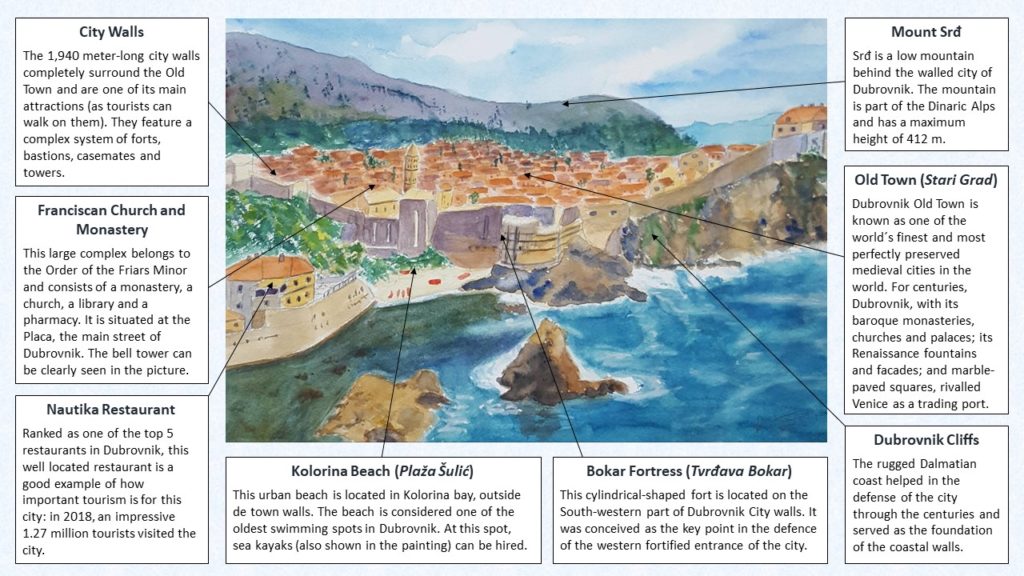
This painting represents the city of Dubrovnik in 2018 by Lynda Steimer, an American artist born in 1956 who currently resides in California and who has been painting as a pastime over the last 20 years. As an amateur artist, her work (mainly bright-coloured landscapes and cityscapes using watercolour), is not shown in any museum but can be found in some internet websites and in her Instagram account.
The painting shows a contemporary, colourful image of the old town of Dubrovnik (formerly known as Ragusa) situated between the Adriatic Sea in the foreground and Mount Srđ in the background. Modern Dubrovnik is a top tourist destination, with its crystal-clear waters being one of its many attractions. For centuries, Dubrovnik has always depended on the sea (it has been nicknamed “The Pearl of the Adriatic”). So, it is no surprise that fishing, seamanship, and sea cuisine are an essential part of local culture and come almost like second nature to the local population. As for Mount Srđ, it is a popular destination with tourists as a viewpoint from which is possible to see the city of Dubrovnik, Lokrum island, the Adriatic Sea and many local attractions. At the top of the mountain there is a white stone cross and a defensive structure called Fort Imperial built by the French in 1810 during the Napoleonic Wars.
The cliff and city walls divide the painting and are a key part of the composition, as a sign of the importance they had on the city defense for centuries. The walls were built systematically throughout history, especially in difficult times when permanent danger of foreign attacks lured over the City and the Dubrovnik Republic. They have been preserved to the present day and are still functional. Throughout History, the freedom of Dubrovnik had been threatened many times. The last time, in the 1990s, during the Serbian aggression, when the walls regained once again their original defence function. The Dubrovnik city walls were impressive for their compactness and quality of stone walls, whose structure, position and shape remained almost intact until the present day.
Between the walls and the hills, the picture portrays Dubrovnik’s Old Town (Stari Grad). Although this art work shows basically an ensemble of red-tiled roofs and pays little attention to details, the Old Town, a UNESCO World Heritage site, is the result of meticulous reconstruction after the earthquake of 1667. Many renovations were also done to return the city to its former splendour after it was attacked during the civil war of the early 1990s. Today, the Old Town of Dubrovnik is a great example of a medieval planned city that preserved important elements of medieval fortified city structure: the city walls, the layout of streets and squares, impressive public buildings and most of the private residential buildings.
The urbanistic-architectonic complex of the Old City of Dubrovnik is made of an orthogonal street grid, formed by strictly regulated: street widths, spaces for residential and public places, type of construction material for buildings, streets and squares and advanced public utilities infrastructure. Little of this complexity can be seen in the picture, in which the only landmark that can be clearly identified is the Franciscan Monastery with its bell tower, displaying the limestone colour that is so common in the Old Town facades. The monastery was originally built in 1317 and rebuilt in the XVII century after being destroyed by the 1667 earthquake. Trees are not abundant in the Old Town; however, the painting reflects that there are a few of them by showing some shades of green dotting the red landscape.
It is worth noting that the Dubrovnik area is marked on the seismic hazard map as an area of the highest possible risk, with earthquake intensity of 8-10 on the Mercalli scale. Authorities carry out researches which help in systematizing valuable data needed for the implementation of seismic repair. This played a very important role in repairing the entire historic centre damaged in the catastrophic earthquake of 1979 and also, in repairing and reconstructing the historic centre after the destruction of the 1990-1992 War.
Nowadays, the walls serve for tourism purposes, by far the main economic activity of modern Dubrovnik. The walls and Old Town are a magnet for many tourists which enter the city through two narrow entry and exit gates. As a result, the city is expanding its tourist offer with bars, restaurants and other service industries to provide for an increasing number of tourists; however, this trend also comes with its own problems: infrastructural, demographic, sociological, safety issues, etc. The city has already taken measures to limit the number of tourists that overwhelm the old town, especially from cruise ships. Most of them come from the UK, the USA, Germany, France and Spain being the most numerous.
In summary, during the post-war years Dubrovnik has been able to master the use of the resources and environment that are well shown in Steimer’s painting (a unique combination of its picturesque location between the sea and the mountain, the historical appeal and charm of its Old Town, its location in the beautiful Dalmatian coast combined with its Mediterranean climate of warm summers and mild winters) to become one of the most desired tourist destinations in Europe. Now, its challenge is different: being able to exploit all of its assets in a sustainable way.
Sara Naval Rodríguez
